

THE NOVEMBER 2022 in this month’s issue The CHR Letter Endometriosis: The Condition Nobody Knows Much About, Part I 2023 Foundation for Reproductive Medicine Conference Program A Piece of My Mind: How Patients and Physicians are Increasingly Losing Control Over Medical Practice Recently Published PeerReviewed CHR’s Publications Questions Patients Ask The CHR’s Interpretation of Recent Literature, Relevant to Reproductive Medicine 03 07 10 15 19 21 24
The CHR is known as a “fertility center of last resort,” primarily serving patients who have previously failed treatments elsewhere. Among CHR’s areas of special expertise are treatments of “older” ovaries, whether due to advanced female age or premature ovarian aging (POA), immunological problems affecting reproduction, repeated pregnancy loss, endometriosis, polycystic ovary syndrome (PCOS), tubal disease, male factor infertility, etc.

Missed the last issue of The VOICE? Access previous issues on thechr.com

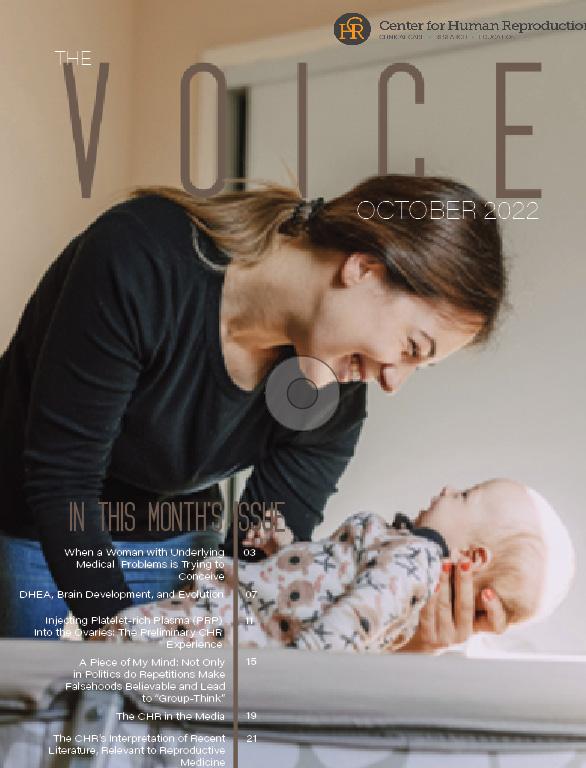
THE CHR



BOARD-CERTIFIED RE-I AT ASSOC. PROF/PROFESSOR LEVEL
The CHR is looking for another senior board-certified RE-I (or international equivalent) to join our growing national and international practice. Though private, our center is organized along academic principles in that physicians are expected to excel not only as clinicians but also as researchers. The center’s uniquely structured compensation package, therefore, incentivizes both activities. We are looking for an individual with documented excellence in both areas, commensurate with associate professor/professor level. Besides a competitive salary, incentive bonus structure, and excellent benefit package, the CHR also offers partnership along either a 3-year or 5-year equity track and, ultimately, part or complete ownership, as the current leadership is expected to retire within that time-period.
If you feel qualified for the position and share our philosophy of being a physician-scientist, please let us know by submitting your C.V. and a brief letter of interest to our COO, Ms. J. Tapper, at jtapper@thechr.com. The position can be filled immediately. All submissions are considered confidential.

WITH THE CHR
www.thechr.com @CHRNewYork @CHRNewYork@CHRNewYork
CONNECT
2 | november 2022 | The Voice
hirinG AT
ADVERTISEMENT
the voiCe
The CHR is delighted to offer the VOICE’s November issue to our readers, as always attempting to present material for our very diverse readership, first and foremost made up of CHR’s past and present patients, but also electronically mailed out to thousands of physicians, mostly obstetricians & gynecologists and reproductive endocrinologists/infertility specialists (REIs), but also to many primary care providers in different medical specialties. And then there are, of course, the many thousands of daily visitors to the CHR’s website who now have the opportunity to read the VOICE electronically in “book format” (if you have not seen this change yet, give it a try; it’s worth it!)
With on average 90,000 visitors a month, the CHR’s website is not only one of the most visited websites among fertility centers worldwide but, likely because of the diversity of its content, also one of the most visited infertility sites among websites in general that offer fertility-related information. Remarkably, the outreach is not only restricted to the U.S. but spans the globe, likely a principal reason why roughly one-third of CHR’s patients come from outside the U.S.
With so many different target groups among the readership, the VOICE in every issue is trying very hard to address their diverse interests, as again demonstrated in this month’s issue: The front part of each newsletter is primarily geared at patients and/or readers who mostly are seeking fertility-related information out of personal interest or for personal use. In this issue we, for example, are premiering series of articles on ENDOMETRIOSIS that will continue in coming issues. The latter part of the VOICE then, however, transitions more toward medical professionals and researchers. At the same time, writers and editors however also always attempt to keep articles simple, so that even critical reviews of the medical and scientific literature, primarily of course geared at professionals, are also accessible to interested non-professionals.
Those among our readers who have remained steady consumers of this newsletter since its early days, have, of course, witnessed a very significant metamorphosis and expansion of the VOICE, which is the consequence of a steady learning process, largely dependent on the feedback we receive from our readers. If you have something to say, we, therefore, as always want to encourage you to do so. We also continue to encourage submissions for potential publication in the VOICE, whether in the form of comments to articles previously published or as original submissions. For further information, please contact Micah Elias (he/him) at melias@thechr.com
NOVEMBER 2022 The V oice | november 2022 | 3
The Editorial Staff
IVF Coverage Refusals by Insurance Companies are Expanding

Something very strange is going on in the infertility field when it comes to insurance coverage for IVF cycles. So strange, indeed, that we have decided to dedicate a steady monthly corner to the subject in the VOICE, - at least while those oc currences are continuing. In recent months things have definitely gotten worse and worse.

Cycle denials are especially increasing for patients with OXFORD/UNITED coverage, only one of two insurance con tracts the CHR has maintained over the years because reimbursements remained reasonable and administrative burdens were tolerable. As repeated patient experiences over recent months, however, demonstrated, the latter is definitely no longer the case; and it would not surprise if, considering the obvious changes we have been observing in how this insurance company now manages its patient portfolio when it comes to IVF services, we may find ourselves forced to cancel this contract, as the CHR has done with several other contracts over the years.
Here are a few recent examples for how unreasonable and unpredictable this insurance company has become in its ap proval process for IVF cycles: We in a recent issue of the VOICE reported that cycle denials started with a patient being denied approval because the insurance company considered the gonadotropin dosage she was prescribed as too high. Since lowering the dosage was the only option to get her coverage for the cycle, it was accordingly reduced, and she produced a smaller number of eggs than had been expected. Another patient, already described in the October issue of this newsletter , was denied approval for an IVF cycle because she , simply, was scheduled to receive an anticoagulant during her cycle, which the carrier considered “unneeded.”
Coverage for a third patient’s IVF cycle was withheld only a few weeks later for an even more whimsical reasons: Since her levels were low, she had been prescribed vitamin D supplementation. Considering vitamin D supplementation unnecessary, once again this fact, alone, was enough for the insurance company to reject coverage. In a peer-to peer conference with a physician representative of the insurance company, he quoted a reference for the company’s opin ion, which the treating CHR-physician demonstrated to be out of date by providing in a letter to the insurance company a more recent reference recommending vitamin D supplementation in infertile women with low levels of the vitamin. Though weeks have passed since, we have not yet received a response from the insurance company.
And here is the most recent and to some degree most bizarre case of cycle denial: A 40-year-old poor prognosis patient who had no problems to get approved for her first two IVF cycles at the CHR, for her third cycle, suddenly, was denied approval with the argument “that there was no medical indication for a third cycle.” In an again by the treating CHR physician requested peer-to-peer consultation, the company representative explained that the company’s decision had been based on the medical record indicating that the patient had “an egg-problem.” Under the the insurance compa ny’s guidelines, “egg problems” apparently were cause for cycle denial. Since the decision was based on the company’s guidelines, the physician was not impowered to change the decision. The patient’s only choice was to submit a formal appeal.
That the poor prognosis of this still very young patient meant that time was not on her side, did not impress the insurance company’s medical representative. Nor was he impressed by the argument that almost all women coming for fertility ser vices to the CHR demonstrate an “egg problem” and, therefore, under these guidelines would be ineligible for any IVF cycle approvals. It, therefore, increasingly looks like OXFORD/UNITED insurance plans, though claiming to offer IVF coverage, in reality exclude eligibility for such coverage for a significant number of even still young patients with infertility under medically completely unwarranted reasons , including the in this contex almost bizarre diagnosis of an “egg problems,” - of course one of the most common causes of female infertility. OXFORD/UNITED patients should be aware of this and let their employer’s benefit department know! The CHR, of course, continues fighting for every egg and embryo for every CHR patient, whatever the insurance coverage!
YOUR INFERTILITY INSURANCE ADVERTISEMENT 4 | november 2022 | The Voice
AWARD FOR
RECEIVE
OF



DRS. GLEICHER AND BARAD
PRESTIGIOUS ASRM
BEING SELECTED NINE YEARS IN A ROW FOR PRESENTATIONS AT THE ANNUAL CONFERENCE
THE ASRM The V oice | november 2022 | 5
Gleicher was wonderful. He was very generous and took the

TESTIMONIALS
PATIENT TESTIMONIALS PATIENT TESTIMONIALS
6 | november 2022 | The Voice
PATIENT TESTIMONIALS PATIENT
Dr.
time to answer all my questions and explain different processes. - A Patient “ “ Very knowledgeable and helpful. - A Patient
ENDOMETRIOSIS
ENDOMETRIOSIS
THE CONDITION NOBODY KNOWS MUCH ABOUT PART I
At most only a small number of subjects in female medicine are surrounded by as much “mystique” as the condition known as ENDOMETRIOSIS. Because endome triosis clinically affects women especially during reproductive years, it is errone ously widely perceived as mostly a reproductive disease, causing infertility and, on occasion, also causing pelvic pain and several other symptoms. Endometriosis is, however, a much more complex condition than that, and in many women because of significant symptoms greatly affects quality of life. We here, therefore, offer PART I of a series of articles on endometriosis , to be continued in future issues of THE VOICE, in an attempt to offer our readers a detailed view of how clinicians and scientists at THE CHR currently view this condition.
AN INTRODUCTION REFLECTIVE OF HOW LITTLE WE REALLY KNOW ABOUT ENDOMETRIOSIS
By many considered the most frequent cause of female infertility, endometri osis is, however, much more than just an infertility diagnosis. The mere fact that the general prevalence of endo metriosis in a general population is still unclear, already points out how little is known about this chronic disease. And a chronic “disease” it, indeed, is for which we, still, have no good treat ments. Worldwide millions of women suffer from endometriosis. As the liter ature suggests, somewhere between 2 and 10 percent of U.S. women suffer from this diagnosis.1 As a public health problem, there, of course, is a huge difference between these two preva lence numbers.
Endometriosis is defined by small islands of endometrium-like tis sue (including glands) being found where they do not belong. As the name suggests, endometrial tissue is not expected anywhere but in the
endometrial cavity of the uterus. In women with endometriosis, small islands of such endometrial tissue are, however, found outside the uterus, mostly in the pelvic area but can also be present higher up in the abdominal cavity on bowel, omentum, and even on the diaphragm. Endometriosis has, indeed, also been detected in lungs, potentially causing a bloody cough and sputum, though the pelvic cavity is clearly where most endometriosis is seen. Fallopian tubes and ovaries are the most frequently affected organs, though the utero-sacral ligaments posteriorly holding the uterus in place are by some considered even more often affected. When those ligaments are invaded by endometriosis, women frequently complain during intercourse with deep penetration about a sudden stabbing pain. Together with painful periods (so-called dysmenorrhea) and general pelvic pain, this uterosacral pain is, indeed, considered one of the most typical symptoms of the disease. General pelvic pain, in contrast, is often linked to ovulation since, as the whole ovary enlarges as follicles grow, adhesions (scar tissue) formed by
endometriosis get stretched and can become very painful.
Adhesion formation with endometrio sis is very typical because the little is lands of endometrial tissue outside the uterus are under the same hormonal control as the endometrium. When a woman menstruates, those small is land, therefore, also “menstruate” (i.e., bleed). Inside pelvic and abdominal cavities the female’s immune system, however, considers these bleeding islands to be open wounds that must be healed. And healing, like in the skin, means scar-formation. Scar-tissue formation is, therefore, a characteristic feature of endometriosis and can lead to pain as well as infertility.
Endometriosis is, however, in many aspects a “strange” disease: For example, the more severe a pain-caus ing disease usually is, the more severe will in most cases the pain be. Endometriosis, however, does not offer such a correlation: A woman may have very minimal disease and suffer from excruciating pain or may have the most severe stage of disease (stage IV) and be completely asymptomatic. While this is in textbooks explained by location of endometrial implants (the closer to nerve fibers the more pain ful), the truth is that, to this day, this is only one of several still unexplained characteristics of endometriosis.
One of the most surprising is the fact that, to this day, we do not know for certain how endometriosis happens: The most popular hypothesis has been for decades the Sampson’s theory of retrograde menstruation, which proposes that women not only men struate transvaginal, but also, retro grade through fallopian tubes into the pelvic and abdominal cavities.2 Some
The V oice | n ovember 2022 | 7Continued on page 6
endometrial cell clusters then, instead of going through degeneration and absorption, implant and, once that happens, a patient by definition has endometriosis. Endometriosis, based on severity of observed lesions, is staged like cancer into stages I-IV, with stage IV representing the most severe ly affected patients with, due to severe adhesions, called a “frozen pelvis.”
Endometriotic lesions can also invade the muscle of the uterus. The condi tion is then called adenomyosis. That endometriosis can in extremely rare cases also be found in males,3 convinc ingly suggests that Sampson’s theory of retrograde menstruation cannot be the only cause of endometrioses. Among several other hypotheses, metaplasia of coelomic epithelium has, indeed, become the second-most often suggested cause.4 That retro grade menstruation cannot be the only pathophysiology is also demonstrated by premenarcheal females having been diagnosed with endometriosis.5
On the other age extreme, endome triosis, widely believed only to be a disease of reproductive years, has also been diagnosed in postmenopausal women.6

Though most frequently diagnosed during reproductive years, all of these unexpected observations have only further confused the evolution of a single, logical hypothesis for the occurrence of endometriosis. A very recent study, indeed, implied the existence of a peritoneal immunologic tolerance-niche in women with endo metriosis that allows for implantation of endometrial cells which in most women is not allowed by the female immune system.7
Likely the most important obstacle to understanding endometriosis better has, however, been the fact that we can never be certain whether a woman has endometriosis or not since many very mild cases can only be microscop ic: i.e., neither laparoscopy (widely still considered the only reliable diagnostic
modality for the condition) nor MRIs of pelvic organs may reveal microscopic disease. Such microscopic disease, nevertheless, can be severely symp tomatic and, often, can only be proven through multiple, often blind peritone al biopsies during laparoscopy.
This inherent unreliability of diagnosis is, likely, a main reason for the previ ously noted wide disparity in reported endometriosis prevalence in different population studies. This fact also, especially among proponents of the Sampson theory of retrograde men struation, led to the suggestion that, to at least a minor degree, every wom an may have endometriosis. Were this, indeed, to be confirmed, one would have to wonder whether endometri osis should really still be considered a disease or the extreme spectrum of physiological normality.
Symptomatology of endometriosis in addition can find rather bizarre expres sions: We already noted that rare cases of pulmonary endometriosis can lead to bloody productive cough. A recent case report described a woman with thoracic endometriosis presenting
with a hemopneumothorax.8 In a dif ferent extreme, rectal endometriosis can lead to bloody stools during men struation9 and can be misdiagnosed as Crohn’s disease 10 or even rectal cancer.11
All of these unusual characteristics of endometriosis, of course, raises sever al very important questions. The most important is, likely, how can one study a medical condition without even being able to ascertain whether a pa tient is afflicted by the disease or not? For any study design this, of course, means that control populations with out alleged disease in endometriosis studies with considerable likelihood are heavily contaminated by women with only mild disease. How we expect to understand the disease of endome triosis if we do not even understand its etiology and pathophysiology is very likely an almost equally serious concern.
Like in many areas of reproductive medicine, progress in our understand ing of endometriosis has unfortu nately basically stagnated over recent decades. Considering above outlined
8 | november 2022 | The Voice Continued from page 5
barriers to a better understanding of this highly threatening disease for millions of women, this should not surprise. It, therefore, is important to understand how little we know about endometriosis and how subjective our often mostly anecdotal experiences affect how we (and, of course, col leagues) respond to this disease. Our continuous exploration of this subject in future issues of the VOICE should, therefore, be consumed with the nec essary humility.
• The importance of timely diagnosis

• Endometriosis as a gynecological
• the immunology of endometriosis
• THE IMPORTANCE OF DIET
• Endometriosis as a fertility diagnosis

1. https://www.hopkinsmedicine.org/health/ conditions-and-diseases/endometriosis
2. Jensen JR, Coddington CC 3rd.Clin Obstet Gynecol 2010;52(2):379-388
3. Rei et al., Case Rep Obstet Gynecol 2018; 2083121
4. Sourial et al., Int J Reprod Med 2014;179515
5. Marsh EE, Laufer MR. Fertil Steril 2005;83(3):758-760
6. Secosan et al., Diagnostics (Basel); 2020;10(3):134
7. Tan et al., Nat Cell Biol 2022;24:1306-1318
8. El Haj Chehade et al., Monaldi Arch Chest Dis 2022; doi:10.4081/monaldi.2022.2401. Online ahead of print
9. Keith et al., Catamenial rectal bleeding due to invasive endometriosis: a case report. J Med Case Rep 2020;14(1):61
10. Popivanof et al., Ileus cause by small bow el, ileocecal and rectal endometriosis misdi agnosed as Crohn’s disease and managed by synchronous ileocecal and rectal resection. Ann R Coll Surg Engl 2020;102(8):e205-e208
11. Hu et al., Rectal endometriosis mimick ing primary rectal adenocarcinoma. Diagn Cytopathol 2021;49(12):E437-E442
AT THE CHR
ONE or TWO-YEAR CLINICAL FELLOWSHIP in RE-I If you failed in securing a formal fellowship position in RE & Infertility or simply want a change out of gener al OB/GYN practice, the CHR offers a fellowship position in RE-I which after 1 year will greatly improve competitiveness for a formal fellowship position and in 2 years establishes independent competence for establishing an infertility practice. The center’s last 1-year fellow was accepted into the NIH-fellowship program after failing to secure a position in the preceding year.
Qualified candidates must be OB/GY board-eligible or certified, be eligible for hospital privileges and for a New York state license to practice medicine. As CHR maintains a very active research program in affiliation with Rockefeller University, CHR fellows gain substantial research experience, with great likeli hood resulting author- or co-authorships in peer-reviewed publications. Board eligible candidates who still must accumulate surgical cases will be given the opportunity to do so.
Chosen candidates will receive a very competitive salary and a generous benefit package, including health and malpractice insurance as well as paid vacation time. If you feel that you qualify and are interested in a career in RE & I, please submit your CV and a brief application letter to our COO, Ms. J. Tapper, at jtapper@ thechr.com. The position is available as of January 1, 2023. All submissions are considered confidential.
SELECTED FUTURE HEADINGS OF THE SERIES
condition
REFERENCES
ADVERTISEMENThirinG
The V oice | november 2022 | 9 Continued from page 6 ADVERTISEMENT
RESERVE THE DATES!
The 2023 FOUNDATION FOR REPRODUCTIVE MEDICINE CONFERENCE (FRMC) in New York City IS BACK December 1-3, 2023

Translational Reproductive Biology and Clinical Reproductive Endocrinology
The mottos: Think differently! and Paradigms you will not hear elsewhere!
Conference Sponsors: The Foundation for Reproductive Medicine (FRM) The Center for Human Reproduction (CHR) The International Do No Harm Group in IVF (IDNHG-IVF)
Weare pleased to be back! In a mildly irreverent way, the FRMC over 3 conference days links evolving basic science with cutting edge clinic practice, in the process hopefully facilitating translational connections between basic science laborato ries and clinical fertility practice. The purpose is to demonstrate to clinicians what is possible and to inform basic scientists about what is needed. The intent is not to dream about the future, but to demonstrate what is possible now. FRMC has become the conference where new paradigms in reproductive medicine frequently premiere and where speakers as well as audi ence are encouraged to think differently. Every program, therefore, evolves over the preceding year, as new findings are reported in basic sciences and clinical journals. The program, therefore, always goes where scientific and clinical emphasis currently is. Earliest stages of embryo development never fall out of fashion because they, of course, contain all the information for almost everything, - life, death, regeneration, immune tolerance, etc. The FRMC is also never bashful about addressing controversial issues.
Dramatic worldwide declines in IVF live birth rates since 2013 have, surprisingly, still not attracted attention - only more reason to raise the issue at FRMC 2023. It does not even take particular insight to conclude that those declines must relate to changes in IVF practice patterns over the last decade, with the most consequential (especially in the USA) being the expansion in utilization of preimplantation genetic testing for aneuploidy (PGT-A), despite publication of significant new evidence that PGT-A in not only fails to improve IVF outcomes but, in certain sub-populations, actually harms them.
A brand-new headline for the conference is precision medicine. Since the FRMC always promoted more individualized IVF practice, one may argue, that the concept is nothing new. With precision medicine in these days gaining in popularity in other medical specialties, it, nevertheless appears timely to familiarize the IVF community with this practice within the context of infertility practice. As we have moved the date of the conference smack into the middle of the pre-Christmas shopping season in NYC, there is post-COVID no better time and plan to visit at this time of the year.
Continued on page 11 10 | n ovember 2022 | The Voice
PRELIMINARY CONFERENCE PROGRAM
THE FACULTY WILL BE ANNOUNCED SHORTLY DAY 1: Thursday, December 1st, 2023

08:30- 08:35 Welcome 08:35-08:45 THE YOUNG INVESTIGATOR REWARD 08:45-09:30 THE OPENING LECTURE: What is wrong with current medical publishing?
Session 1 IMPORTANT NEW DEVELOPMENTS: Part I
09:30-10.00 THE BREAKING NEWS LECTURE: TBA
This lecture will reflect a very recent publication of importance and, therefore, will not be announced until ca. 30 days before the FRMC 10:00-10:30 Rejuvenating the microenvironment of the aging ovary 11:30-11-00 Human blastoid models to advance our understanding of early-stage embryos 11:30-12:00 COFFEE BREAK and Poster Viewing in Exhibition Hall
Session 2 PGT-A’s PERSISTENT DISCREPANCY BETWEEN SCIENTIFIC REALITY AND CLINICAL PRACTICE. Part I
12:00-12:30 THE INTERNATIONAL DO NO HARM GROUP IN IVF (IDNHG-IVF) LECTURE PGT-A practice as a reminder for responsible introduction of innovative treatments into reproductive medicine. 12:30-13:00 Physiological, biological, technical, and mathematical reasons why PGT-A simply cannot work 13:00-14:00 LUNCH BREAK DEBATE 13:00-13:20 Get your lunch “to-go”
13:20-14:00 DEBATE: Should we transfer selected chromosomal “abnormal” embryos?

Session 3 PGT-A’s PERSISTENT DISCREPANCY BETWEEN SCIENTIFIC REALITY AND CLINICAL PRACTICE. Part II
14:00-14:30 What happens to poor prognosis patients who use PGT-A
14:30-15:00 What is the pregnancy potential of unused and/or discarded “abnormal” embryos after PGT-A? 15:00-15:30 Can non-invasive PGT-A save PGT-A? 15:30-16:00 COFFEE BREAK
Continued from page 10 The V oice | november 2022 | 11
Session 4 QUESTIONING “GROUP THINK,” THE ANTI-THESIS TO “PRECISION MEDICINE”
16:00-16:30 Is the concept of embryo selection in IVF still sustainable? 16:30-17:00 Why are we using extended embryo culture to blastocyst for almost all IVF cycles? 17:00-17:30 Another critical look at elective single embryo transfer 17:30-18:00 THE DAILY SUMMARY: QA with the day’s faculty 18:00-20:00 WELCOME RECEPTION DAY 2: Friday, December 2nd, 2023
Session 5 NEW PRARADIGMS IN REPRODUCTIVE BIOLOGY AND CLINICAL PRACTICE, CLINICALLY STARTING TO APPROACH “PRECISION MEDICINE”
THE FOUNDATION FOR REPRODUCTIVE MEDICINE LECTURE
08:30-09.00 The function of micronuclei in cancer cells: Is there relevance to the preimplantation-stage embryo? 09.00-09:30 Chromosomal analysis of extruded cells/fragments in preimplantation-stage embryos. 09:30-10.00 How follicles and oocytes change with advancing female age: Highly Individualized Egg Retrieval (HIER) as an important step toward “precision medicine” 10:00-10:30 Have you heard of polygenic risk scoring – the genetic testing industry’s next big product to sell in association with IVF?
10.30-11:00 COFFEE BREAK and Poster Viewing in Exhibition
Session 6 WITH INFERTILITY PATIENTS STEADILY AGING, MEDICAL PREEXISTING DISEASES IN PATIENTS ASSUME EVER GREATED IMPORTANCE
11:00-11:30 THE CENTER FOR HUMAN REPRODUCTION LECTURE

As the primary cause of maternal mortality in pregnancy, why are so many women still dying from various cardio-vascular diseases in pregnancy? 11:30-12:00 Does pregnancy affect DNA methylation and, therefore, biological age? 12:00-12:20 Frozen-thawed embryo transfers increase the risk of hypertensive diseases of pregnancy 12:20:12:40 For how long can IVF cycles for a larger good be safely delayed?
12:40-13:00 What Increased cancer risk following peripartum cardiomyopathy (PPCM), increased autism risk in offspring and increased short-term cancer risk in mothers with inflammatory bowel disease tells us about the maternal immune system in pregnancy
13:00-14:00 LUNCH BREAK DEBATE 13:00-13:20 Get your lunch “to-go” 13:20-14:00 DEBATE: Are there embryos that may benefit from cryopreservation and delayed embryo transfers?
12 | n ovember 2022 | The Voice
Session 7 IMPORTANT NEW DEVELOPMENTS: Part II
14:00-14:30 mtDNA transfer can be horizontal: A mechanism to restore compromised mitochondrial function in embryos?
14:30-15:00 Shining some light into the black box of implantation by using human stem cellderived blastoids
15:00-15:30 TBD
15:30-16:00 COFFEE BREAK and Poster Viewing in Exhibition Hall
Session 8 IMPORTANT NEW DEVELOPMENTS: Part III
16:00-16:30 TBD
16:30 – 17:00 Losing pregnancies, - a matter of chromosomes and/or maternal discretion as recipient of a semi-allograft?
17:30 - 18:00 The importance of insulin-like growth factor 1 (IGF-1) in follicular physiology – an important consideration in using human growth hormone (HGH) in IVF
18:00– 18:30 THE DAILY SUMMARY: QA with the day’s faculty

18:30 BUS PICK UP FOR FACULTY DINNER 19:30-21:30 FACULTY DINNER DAY 3: Saturday, December 3rd, 2023
Session 9 IMPORTANT ISSUES IN IVF TO RECONSIDER
08:30-09.00 Do PCOS phenotypes really exist or is what we currently describe as PCOS really an amalgam of two distinct genomic entities? 09:00-09:30 Where do we stand with social egg-freezing, now that we know that it is not very effective at older ages? 09:30-10:00 Issues arising from increased utilization of IVF 10:00-10:30 COFFEE BREAK and Poster Viewing in Exhibition Hall
Session 10 HAS THE PRACTICE OF IVF BECOME TOO INDUSTRIALIZED AND COMMODITIZICED?
10:30-11:00 Unintended consequences of industrialization and commoditization of IVF practice 11:30-12:00 The hole in the supervisory role of the FDA regarding “laboratory-developed tests:” A major reason for the proliferation of useless and/or harmful “add-ons” to IVF? 12:00-12:30 Can in vivo fragmentation of ovarian tissue and/or intraovarian injection of PRP really be considered “ovarian rejuvenation.”?
12:30-13:00 THE DAILY SUMMARY: QA with the day’s faculty
FORMAL REGISTRATION WILL START IN EARLY 2023. FOR FURTHER INFORMATION AND/OR PREREGISTRATION, PLEASE CALL Alexandra Rata at (212) 994-4400 OR E-MAIL TO arata@thechr.com
The V oice | november 2022 | 13 Continued from page 12
EMBRYOLOGY
SUPERVISOR FOR RESEARCH
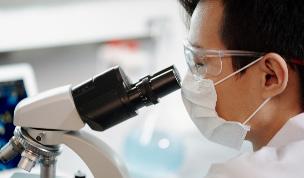
The

Supervisors
While
Besides a
position

and
with
of
new start-up
itself.

LABORATORY
CHR is searching for a candidate for the newly created position of Embryology Laboratory Supervisor for Research. The CHR’s em bryology laboratory, under a single laboratory director, is in the process of being reorganized into three distinct areas with separate supervisory responsibilities: (i)clinical, (ii)administrative, and(III)research.
in all three areas must hold PhD degrees (or equivalent) and be fully trained human embryologists
sufficient historical professional experience to hold a supervisory position.
such human embryology experience is preferred for this new position as well, priority qualifications are a record of excellence in reproductive biology research, documented by publications in prestigious peer-reviewed journals and, in absence
human IVF experience, at least substantial animal IVF experience allowing for relatively quick in-house training in human IVF.
competitive salary and benefit package, the CHR also offers in this
a unique financial incentive-structure linked to the success of the center’s research activities, as demonstrated by publications in prestigious peer-reviewed journal. Moreover, this position will also be eligible for the opportunity to earn shared ownership in research-driven
companies
the center
If you feel that you qualify for this position, please submit your CV and a brief application letter to the CHR’s COO, Ms. J. Tapper, at jtapper@thechr.com. The position is available immediately. All submissions are considered confidential. hirinG AT THE CHR ADVERTISEMENT 14 | november 2022 | The Voice Learn more by accessing our library of educational videos: https://www.centerforhumanreprod.com/contents/video-gallery Center for Human Reproduction
MIND MY A OF
 By Norbert Gleicher, MD Founder, Medical Director and Chief Scientist
By Norbert Gleicher, MD Founder, Medical Director and Chief Scientist


The CHR, New York, N.Y.
One of the most frequently heard cliches permeating medical practice in the U.S. is the notion that medical care is to be determined in the in teraction of patient and physician. The Code of Medical Ethics from the American Medical Association (AMA) in its first paragraph, indeed, defines the practice of medicine as “embodied in the clinical encounter between a patient and a physician (and) as a fundamen tally moral activity that arises from the imperative to care for patients and to alleviate suffer ing.”1 Moreover. federal law strictly defines who is considered a “health care provider “ and/ or “practitioner” (and, therefore, is entitled to provide medical care) as a “a doctor of medicine or osteopathy, podiatrist, dentist, chiropractor, clinical psychologist, optometrist, nurse prac titioner, nurse-midwife, or a clinical social worker who is authorized to practice by the State and performing within the scope of their practice as defined by State law, or a Christian Science practitioner 2
Continued on page 16
How Patients and Physicians are Increasingly Losing Control Over Medical Practice
PIECE
The V oice | november 2022 | 15
Considering these two definitions, one, of course, must conclude that individuals, corporations, and other organizations (includ ing government agencies), not licensed to practice medicine, are, ethically as well as legally, not permitted to do so. And, yet, for several decades the direct influence of corporations and govern ment agencies on often the most intricate and patient-specific medical decisions a physician is confronted with has steadily increased and, at least when it comes to infertility practice, has at times reached almost bizarre levels, - a discussion point I will come back to later.
The government Nothing has made the disruption of the patient-physician rela tionship in determining patient-treatments more obvious than the COVID-19 pandemic. I am here not referring to government powers to order school and business shutdowns and vaccination mandates; government, of course, must have the right, - indeed has the duty to battle national health emergencies. Government, however, also has the moral and likely legal duty to exercise these powers cautiously and fairly, and after careful consider ation of short-term as well as long-term consequences. And this is where most governments have tragically failed during the pandemic, in the U.S. including many state governments and the federal government under Republican as well as Democratic administrations.
It took more than three months into the COVID-19 pandemic in 2020 for (daily on television) Anthony S Fauci, MD, at the time the mains spokesperson of the federal government, to acknowledge that implemented government policies also must be expected to have unintended consequences. Arguing for the need “to flatten” the pandemic’s hospitalization curve so that facili ties would not be overwhelmed, I heard him for the first time mentioning the risk of such unintended consequences as a result of school and business closures only after over three months into the pandemic. By that point, many competent clinical epidemiol ogists (and economists) were already warning about the likeli hood of such unintended consequences, which, of course, in any medical decision-making process must be considered before final decisions are reached.
A clinically practicing physician would know this; but Fauci’s function at the National Institutes of Health, of course, has for most of his career not been that of a practicing physician but, primarily, that of an administrative paper pusher. One, therefore, is left wondering whether he from his earlier days in practice still remembered that provision of medical services for ethical, practical, and legal reasons requires patients’ informed consents before treatments are administered. And a properly administered informed consent always must involve a transparent discussion of benefits as well as risks which, of course, includes short- as well as long-term risks. Since “do-no-harm” is medicine’s first law of professional conduct, benefits must clearly outweigh adverse consequences in order for any treatment to be considered ethical.
If one under such circumstances symbolically considers the nation to represent Fauci’s patient, he should have under stood his obligation as the government’s principal adviser of balancing the need to flatten the hospitalization curve during early COVID-19 days with expected short- and longterm risks of proposed remedies. Yet in over three months he (at least publicly) failed to do so, while aggressively advo cating and promoting government policies, very obviously reached without any thoughts given to unintended longterm consequences.
The government response to COVID-19, of course not only in the U.S., became a telling example of how, as a conse quence of ignorance and/or overconfidence, most govern ments were poorly prepared in exercising regulatory powers over medical care when a worldwide health crisis really called for a comprehensive analysis of options. Instead of modesty, and willingness to listen to varying opinions, Fauci and many other experts only doubled down on their “we know best”- attitude. In watching Fauci’s performance on television, I, for example, never heard him answer a question with, “I don’t know.”
Who then can be surprised that the state of California just passed a law that threatens physicians with loss of their medical license for communicating to their patients’ medical facts that stand in disagreement with what government considers to be medical truth.3 Under that law, “misinforma tion” is defined as a “false information that is contradicted by contemporary scientific consensus contrary to standard of care.” As if scientific consensus and standard of care are constant and/or are always correct. Neither is, of course, the case, since medicine would never progress if both were, indeed, stable. With New York state following so many of California’s laws, we can only hope, that this state will not be next in passing such a ridiculous law.
Insurance companies Medical insurance companies, of course, have a strong economic interest in keeping reimbursements for medi cal services as low as possible. By controlling the financial purse strings, they have been exercising considerable power over what services are covered and, therefore, are reim bursable. Though third-party infertility coverage in the U.S. has increased, it is still very limited in comparison to other developed countries and, even if insurance companies cover IVF services, such coverage is usually restricted to only a small number of cycles and/or to a maximal dollar amount. With very few exceptions, federal government health plans, like Medicaid and Medicare, moreover, do not cover IVF services. Military plans cover IVF mostly only if infertility is the consequence of military injury and/or activity.

Continued on page 16 16 | november 2022 | The Voice
Though there are some exceptions, health plans are legal ly generally mandated to offer insurance coverage for all diseases. By refusing to define infertility as a “disease,” they, however, avoid the legal mandate for coverage, even though the World Health Organization (WHO) recognized infer tility years ago as a disease.4 Increasing insurance coverage over recent years, therefore, did not come form good will of insurance companies but was based on competitive demand from employers who have come under increasing pressure from their employees to offer such coverage. In this way to a degree forced into providing coverage, insurance companies became increasingly aggressive in trying to control their costs in other ways. This initially resulted primarily only in denial of coverage for women considered too old or with too low functional ovarian reserve; but, in more recent months and years, new restrictions really approached almost bizarre levels of micromanagement of IVF cycles, which can only be characterized as direct interventions into patient manage ment, to the best of my knowledge not something insurance companies are licensed for.
This newsletter in recent months pointed out some of those absurd definitions: Some of the CHR’s patients in very recent months, for example, were refused cycle coverage for the following:
• Too high a gonadotropin dosage. The CHR’s treating phy sician was forced to lower the patient’s daily gonadotropin dosage to get her cycle approved. She ended up with a smaller oocyte yield than expected.

• A patient was refused IVF cycle coverage because she was prescribed vitamin D because of low levels. A letter requesting reconsideration of the decision was sent to the insurance com pany, with no answer received in over a month.
• A CHR patient was refused IVF coverage because she, for medical reasons, was prescribed the anticoagulant lovenox in a prophylactic dosage. The prescription had to be withdrawn to get the patient’s cycle approved. The patient was forced to sign an against-medical-advice consent because the CHR physician felt strongly that lovenox was indicated in this patient.
• A patient from Florida consulted with the CHR after she had failed multiple IVF cycles locally at several IVF centers. Her IVF treatment coverage was denied because the CHR was not registered in the state as a qualified fertility provider, even though the CHR has been a registered provider for this national insurance carrier for over a decade.
• The most recent case, given special attention elsewhere in this issue of the VOICE as well, involved refusal of coverage for a third IVF cycle by a major carrier for “lack of medical indication” after the first two cycles had been approved without hesitation. CHR’s treating physician asked for a “peer-topeer” consultation with a insurance company medical director who reaffirmed the denial because “the medical record had indicated that the patient had an egg problem.” Under this insurance company’s in house guidelines, an egg problem in an
infertility patient now apparently disqualifies from coverage. In practical terms this, of course, means most of CHR’s patients will no longer qualify for IVF cycle because most of CHR’s infertility patients have “egg problems.”
In short, insurance companies increasingly get involved in minutiae of treatment protocols, though without taking the medical responsibility for adverse medical outcomes as a consequence of these interventions. The responsibility for such adverse outcomes remains with the treating physician who agreed to a treatment change solely because the patient, otherwise, would not have been covered for her treatment. If this does not represent unlicensed practice of medicine, one wonders, what does?
Hospitals and national provider networks
A recent article described well the economic shake-up the infertility field is in the midst of as a consequence of hos pital networks and Wall-Street-financed provider networks buying up private fertility practices at record pace.5 As the article points out, these changed ownership relationships and resulting incentive structures for in such systems practicing

Continued from page 16
“Though there are some exceptions, health plans are legally mandated to offer insurance coverage for all diseases”
The V oice | november 2022 | 17
physicians create a new practice dynamic that controls utilization, - especially of so-called “add-ons” to IVF, which in almost all circumstances do not offer outcome improvements but do raise patient expenses to signifi cant degrees.
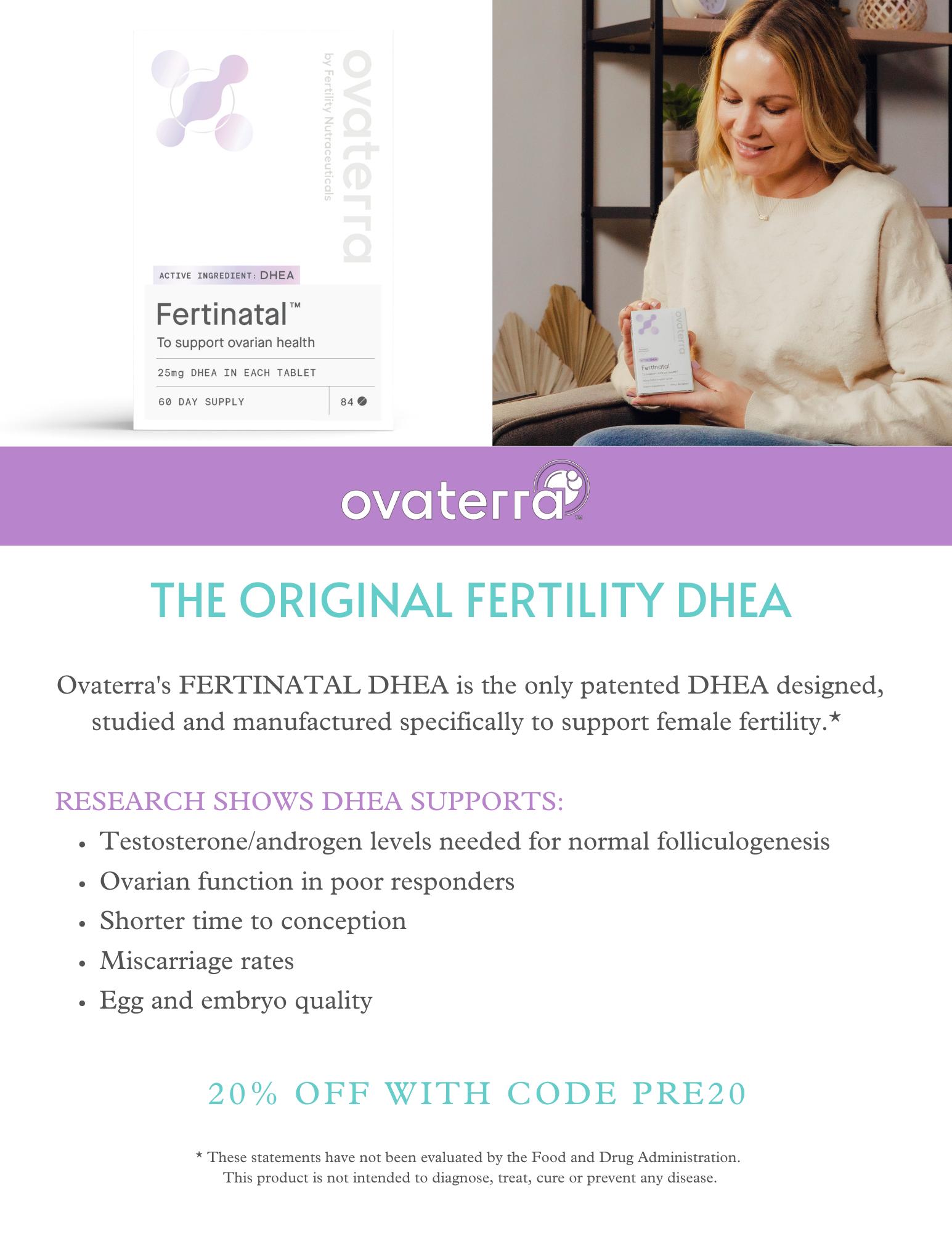
Is there something left to do?
It is interesting to observe that countries with tradition ally socialist medical systems, like most central European countries, Scandinavia, and Israel are experiencing an expansion of private medicine, while the U.S. for the longest time the beacon of private practice medicine, goes the opposite way, with a majority of practicing physicians nowadays already employed and only approx imately 40% (of mostly older physicians) still holding on to their private practices.
In the short-term, I see all of these developments con tinuing, partially driven by the economic realities in the infertility field and in medicine in general described above; but also, because younger physicians these days view medical practice differently from the older gen eration who strongly valued their independence. The younger generation of physicians, much more promi nently represented by women, in contrast values lifestyle over independence and, indeed, whenever possible, favors limited and predetermined hours.
Will the pendulum ever swing back? I don’t see that hap pen in the near future and, therefore, expect ever more profound impingements of non-physician opinions on the clinical practice of medicine, whether from govern ment and/or corporate sources. One, therefore, must expect unintended consequences and, only once those to significant degrees start affecting medical care (and espe cially outcomes, as we already are experiencing in IVF), we may again see a swinging back of the pendulum; but there, unfortunately, is still a way to go before that will happen, and many patients in the meantime will receive inappropriate medical care for all the wrong reasons.
REFERENCES
1. American Medical Association. https://www.ama-assn.org/ delivering-care/ethics/patient-physician-relationships
2. UC Berkley, CA. https://hr.berkeley.edu/node/3777
3. Radcliffe S. Healthline, October 5, 2022; https://www.healthline.com/health-news/ did-california-just-ban-medical-misinformation-what-we-know
https://www.google.com/ search?sxsrf=ALiCzsYvGUB6gMNWVBw1m_

5. Patrizio et al., J Assist Reprod Genet 2022;39(2):305-313; CORRECTION: 39(2):315
THE CHR
The CHR is searching for a qualified candidate to help the laboratory division in performing blood tests, semen analyses, and help with completion of administrative paperwork. Qualified candidates should have at least one year experience in working in a diagnostic laboratory setting.
This position offers a competitive salary and benefit package and is available immediately. For further information or to submit a resume, please contact CHR’s COO, Ms. J. Tapper at jtapper@thechr.com

4.
hirinG AT
LABORATORY TECHNICIAN
. Continued from page 17 18 | november 2022 | The Voice ADVERTISEMENT ADVERTISEMENT
Recently Published Peer Reviewed CHR Publications
NATURE magazine on polygenic risk testing of embryos
An excellent article by science writer Max Kozlov in the September 22, 2022, issue of the prestigious NATURE maga zine addressing the increasingly controversial subject of test ing human embryos during IVF for polygenic risks, quoted, in offering the opinions of several prominent opinion leaders on the subject, also the opinions of CHR’s Medical Director and Chief Scientist, Norbert Gleicher, MD. 1
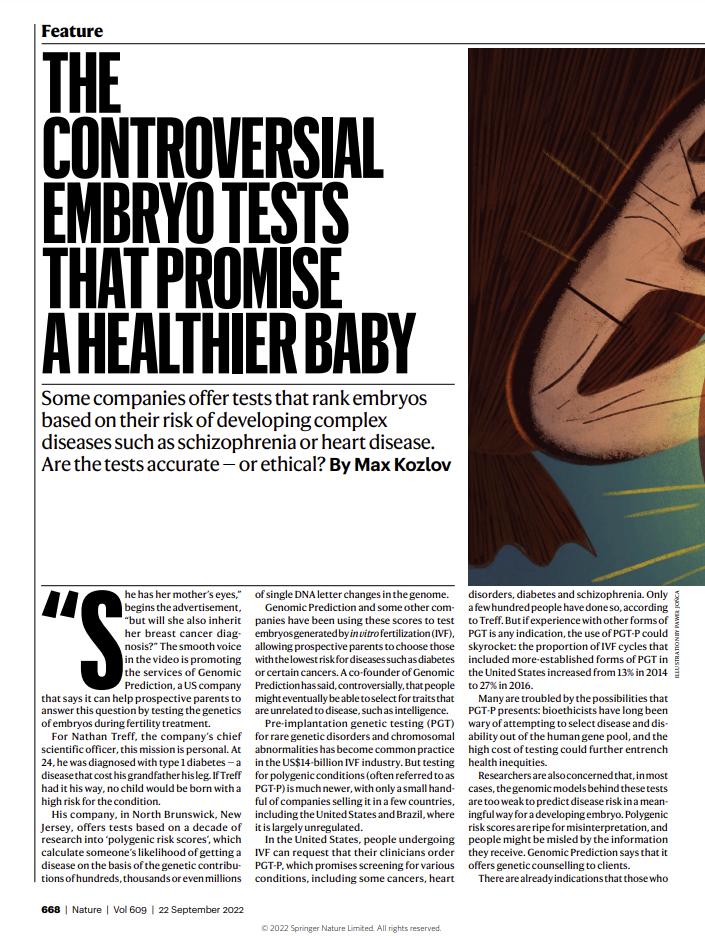
So-called polygenic risk scoring (PGRS) in many ways represents a further expansion of embryo testing prior to em bryo transfer beyond preimplantation genetic testing (PGT), which involves testing for single gene diseases (PGT-S) and/ or chromosomal abnormalities (PGT-A), in that it claims to be able to test embryos for polygenic risks. Most medical diseas es, from diabetes to cancer, are not inherited by single genes but by a combination of several genes which, if present, de note a certain percentage of risk. PGRS, which defines such risks, and requires the sequencing of an individual’s complete genome, has in recent years been subject to increasing num bers of investigations in adult humans in attempts to predict major disease occurrence. But even in this clinical utilization, PGRS is still considered experimental.
As we previously discussed in these pages and in the medical literature in a sister journal to NATURE magazine,2 the ground work for PGRS in human embryos during routine IVF cycles is on even shakier grounds, leading even a major professional organization of geneticists to the conclusion that the utilization of PGRS, as of this moment is unsupported by evidence and, therefore, unethical.3 Yet, following its track record of over 20 years with PGT-A, the genetic testing industry, in cahoots with several IVF centers, of course, does not care very much about what testing is clinically validated or not, and, therefore, what is ethical medical practice, and has started offering PGRS already as a commercial product to test for alleged medical risks,but also for such “important” embryo selection criteria, as blue eyes (also potentially defined by a polygenic risk score).
Also worthwhile mentioning in this context is, again, that in contrast to our European genetic colleagues who had the forti tude of speaking out on the subject,3 regretfully, neither ASRM nor ESHRE demonstrated the same fortitude and neither has the U.S. regulatory authority on the subject, the FDA
For readers interested in the technical reasoning behind current opposition to the unrestricted clinical utilization of PGRS in association with IVF, we vehemently recommend Kozlov’s excellent article. It took quite some time to appear in print but, con sidering complexity of the subject and its ultimate range of detail, the wait was definitely worth it.
REFERENCES
1. Kozlov M. Nature 2022;609:668-671
2. Gleicher et al., Nat Med 2022;28(3):442-444
3. Forzano et al., Eur J Hum Genet 2022;30(5):493-495
CHR CHR CHR CHR CHR CHR CHR CHR CHR CHR
CHR CHR CHR CHR
CHR CHR CHR CHR CHR
The V oice | november 2022 | 19
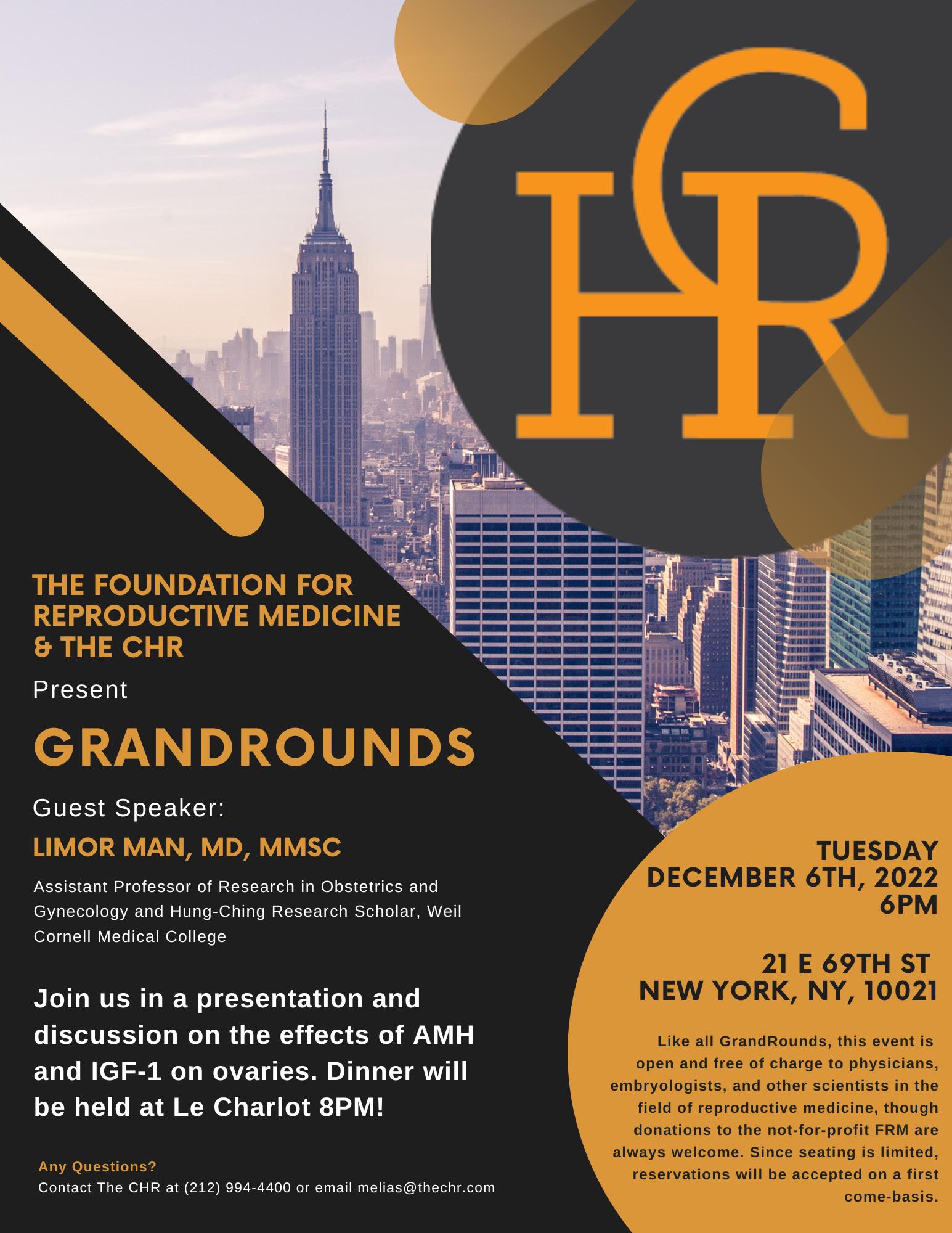
20 | november 2022 | The Voice
QUESTIONS PATIENTSASK
What happens to fertility in cancer survivors?
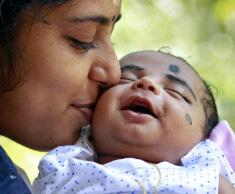
The bad news is that cancer unfortunately can strike at any age, including in young women and men before or during their reproductive years. The good news, however, is that cancers in many of these still very young individuals are increasingly cured, thereby still offering them the opportunity to become parents once their cure has been established.
Whether in women or men, successful treatments for cancers, however, frequently involve medication and/or radiation therapies toxic to their reproductive organs, -ovaries, and testes. This is where the concept of medical fertility preservation of gametes prior to cytotoxic treatments came from. That young patients diagnosed with cancers should be offered fertility preservation is by now well established,1 A very recent review of medical practice in women with cancer, however, once again pointed out that despite increasing utilization, many affected women, still, are not properly informed about and/or are no offered appropriate fertility preservation services.2 That appears even more often the case in young males.3
Fertility preservation should in cancer patients only be pursued if expected treatments to eradicate the cancer are expected to have cyto toxic effects on ovaries or testes, respectively. Such effects can be caused by chemo- or radiation therapy. Attempts at fertility preservation can then in female patients take three distinct routes: (i) A patients diagnosed with cancer can quickly be taken through egg-banking (cryopreservation of eggs) or embryo banking (cryopreservation of embryos) if the female already has a steady partner; (ii) She can have part or a complete ovary removed, with the idea being to cryopreserve the cortical tissue of the ovary, which contains the follicles, or (iii) she can just receive medications which to a degree can weaken the cytotoxic effects of chemotherapy or receive these medications even if she has cryopreserved eggs, embryos or tissue.
Once the patient is then declared cancer-free and cured (usually after 5 years from initial treatment), her subsequent fertility treatment will depend on what her ovarian reserve at that point will be: if still reasonably good, she may still be able to undergo a fresh IVF cycle; if she is in menopause, she can work with her frozen eggs, embryos, or cortical ovarian tissues. Similar principles apply also to cryopreser vation of semen and of testicular tissues in males.


With cryopreservation techniques having greatly improved over the last two decades, the principal issue is no longer survival of

Continued on page 22 The V oice | november 2022 | 21
cryopreserved specimens but the performance of timely cryopreservation. Any cancer diagnosis is widely considered an emergency that requires immediate therapeutic inter vention, whether by surgery, chemo- or radiation, therapy. It also instantly turns an, otherwise, most relaxed individual into a bundle of nerves, and disrupts even the most stable families. The combination of apparent urgency to initiate treatments and family chaos is not a good time for mak ing important decisions. Consequently, patients (and their families) in these moments often mistakenly dismiss con cerns about future fertility, a decision they later, after being declared cured from their cancers, often regret.
Though prioritization of cure over fertility is, of course, a very logical decision, it remains the responsibility of the treating physician, whether an REI or oncologist, to break through this “fog of war” for patients and family by explain ing all of these dynamics at a very crucial and confusing time for patients. Though it often appears so much easier for the physician to just retreat from trying to advance the concept of fertility preservation to patient and family, this, ultimately, is not in the best interest of most young patients. Physicians, therefore, must remain persistent in their support of fertility preservation.
REFERENCES:
1. Oktay et al., J Clin Oncol 2018;36(19):1994-2001
2. Mahmood S., et al., Clin Oncol (R Coll Radiol) 2022;34(8):508-513
3. Delgouffe et al., Front Endocrinol (Lausanne) 2022;13:854186
Can we detect infertility at younger ages?


The Internet is buzzing these days about the concept of “ear ly” diagnosis of infertility, a very logical concept that, sur prisingly, has not received the attention it deserves till now. Investigators here at the CHR, however, years ago attempted to pursue a related idea and, indeed, even were awarded a patent for such an effort several years ago, when claiming that they had developed an algorithm to predict premature ovarian aging (POA) in young women long before they became clinically symptomatic by developing infertility.1
The idea was rather simple: Approximately 10% of women of all races and ethnicities develop so-called POA. This diag nosis means that a woman has fewer eggs left in her ovaries than she should for her age (women are born with all of their eggs and constantly lose eggs from birth on). Since losing eggs is a quiet, asymptomatic process, they are unaware of losing excessive eggs at accelerated pace until they, suddenly, one day no longer can get pregnant, get tested and are found to have abnormally high FSH and abnormally low AMH levels, both hormones then indicating the diagnosis.

Infertility develops when egg numbers fall below a certain threshold, and this point can be reached at practically any


age but only rarely occurs before age 35. Because women now adays have children much later than earlier generations, POA until 30-40 years ago did not even exist as a diagnosis because most women by age 35 had already sizable families and usually no longer minded very much if they no longer conceived. Now, however, with women usually only starting to try conception af ter age 35, POA as become a very significant infertility problem, with many patients in fertility clinics having this diagnosis and, as only option, are left pursuing IVF.
CHR’s investigators, therefore, argued that being able to detect young women at risk for POA before they fall below the approx imal age-35-threshold, would offer them significant potential benefits: They could either decide to have children earlier or they could at still young ages, when their ovaries still contained good egg numbers, freeze their eggs for later use. Calling this program, “What’s my fertility?”, they developed an algorhythm that allowed for such early diagnosis just based on half-a-dozen brief questions and three blood tests.1,2
But POA is, of course, not the only cause of infertility. Female infertility can also have other causes which also not always are symptomatic. And then there is also the male partner who can be cause for infertility (and usually is in ca. 40%). How can one, therefore, diagnose infertility in all of those other cases?
The answer to this question is that there is really no reliable way; - the only option is a heightened level of suspicion leading to early testing. Take for example tubal disease, another major cause of female infertility, In most cases tubal disease is either caused by a tubal infection (often either from chlamydia or gon orrhea infections) or from endometriosis. A young woman who experienced either a tubal infection or has been diagnosed with endometriosis, therefore, should be aware of the risk of tubal disease and in regular intervals should ask her gynecologist to test her tubes.

22 | november 2022 | The Voice
Continued from page 21
Or consider a young woman who has irregular menstrual periods. Such women are often prescribe oral contraceptives to regulate their periods. They, indeed, are very good in doing that and most young women, therefore, believe that their problem has been taking care of. This is, however, not the case at all because the “pills’ just covers up the underlying problem, without treating it. A very frequent cause of irregular periods is, for example, a condition called the polycystic ovary syn drome (PCOS), by many considered the single most frequent cause of female infertility. Women with irregular period often do not ovulate and making them ovulate at younger ages is much easier than at more advanced ages over 35.

One of the most frequently asked question if infertility clinics is, “doctor am I fertile?” The answer to this question always must be, “we don’t know” – because we do not have one unify ing test of fertility. The only reliable way to find out is by trying to conceive through regular intercourse with a male with normal semen. If that does not work within one year (or in 6 months after female age of 38), you have a fertility problem that must be diagnosed. In an asymptomatic patient with negative medical history, we, therefore, can never with absolute certain ty determine whether a fertility problem exists or, even better, that a fertility problem does not exist. The same, of course, also applies to the male partner. Male infertility is in ca. 40% the cause of a couple’s infertility. He may be the healthiest guy on the block; but if his semen analysis is very abnormal, only IVF will likely help the couple to conceive.
In summary, early diagnosis of infertility is strongly advised and is possible in many, though not all cases if the medical history of a patients (and family) hints at the possibility of problems. A perfect test for all female as well as male infertility does not exist (except for trying) but, if a suspicion or predese lection exists, appropriate testing can be done at any time.
REFERENCES:
1. https://www.youtube.com/watch?v=S7NNBLywukw
2. Gleicher et al., Reprod Biol Endocrinol 2015;13:43
Why do embryos arrest?
This is a very important question with much too few answers available as of this point. The question is of such importance because embryo wastage due to arrest during in vitro culture is so frequent: for example, one-third to one-half of all embryos do not reach blastocyst-stage.1 Israeli colleagues recently investigated whether embryo arrest in the IVF lab was related to chromosomal abnormalities in embryos and concluded that this was not the case2 but related to other causes, including culture media. Magdalena Zernicka-Goetz’s laboratory, in contrast, reported selective arrests with certain aneuploidies: for example, monosomies 21 demon strated a high rate of arrest.3
Chinese investigators in a paper reviewed in the October issue of the VOICE observed that most embryo arrests occurred between 3- and 8-cell-stages. They also demonstrated that most arrest ing embryos entered a senescence -like state as a consequence of cell cycle arrest and identified 3 distinct types of arrest based on mechanistic failures. Interestingly, these investigators also were able to reverse some of these arrests with treatment by resveratrol and/ or nicotinamide,4 opening up the possibility of “rescuing” arrested embryos in the lab.
REFERENCES:
1. Gardner et al., Fertil Steril 1998;69:84-88
2. Orvieto et al., Reprod Biol Endocrinol 2022;20:52
3. Shahbazi et al., Nat Commun 2020;11(1):3987
4. Yan et al., PLoS Biol 2022;20(6):e3001682
Does endometrial scratching improve IVF outcomes
Already in 2003 Israeli investigators claimed that local injury to the endometrium doubles the incidence of successful IVF pregnancies.1 Ten years ago, in 2012, British investigators published a cautious systematic review and meta- analysis that suggested that endome trial injury may overcome recurrent embryo implantation failure in association with IVF.2 Almost 100 published studies later, the subject has remained controversial, with an increasing majority of studies dismissing the concept outright3 or finding no substantial benefit.4
CHR has increasingly been using endometrial injury over the last few years only as a last-resort treatment, as presented data in the literature increasingly have questioned the utility of the procedure.

REFERENCES:
1. Barash et al. Fertil Steril 2003; 79(6):1317-1322


2. Potdar et al., Reprod Biomed Online 2012;25(6):561-571
3. Metwally et al., Health Technol Assess 2022;26(10):1-212. https://doi. org/10.3310/JNZT9406
4. Lensen et al., Cochrane Database Syst rev 2021;6(6):CD009517
The V oice | november 2022 | 23
Continued from page 22
the chr’s interpretation of RECENT LITERATURE, relevant to REPRODUCTIVE MEDICINE
Mostly placed into a clinical context, we in this section of the newsletter offer a survey of articles in the English literature, usually published in the preceding month, which the CHR found of interest to the current practice of clinical reproductive endocrinology and infertility, - even if at times not immediately applicable to daily clinical practice. These articles, however, nevertheless often point out where clinical practice will likely go and, therefore, serve an important translational purpose. Translational research has been the CHR’s principal research goal since its founding in 1981, has produced a significant num ber of U.S. patents over the years, and has propelled the CHR into its current position as a worldwide center of last resort for infertile patients who have failed treatments elsewhere.
Pregnancy
After prior approval, FDA on verge of removing Makena® (17-OHPC) from market
Whether intramuscular 17-alpha-hydroxyprogesterone caproate (17-OHP), marketed under the name Makena®, was effective in preventing premature labor in women with a history of at least one spontaneous preterm birth has been controversial since the treatment was initially approved by the FDA and marketed by Covis Pharma. An FDA advisory committee already in 2019 had voted to pull back accelerated approval for the drug. FDA staff now advised the Obstetrics, Reproductive and Urologic Drug Advisory Committee (which at the time of this writing is to meet) that the drug “has not shown to improve neonatal outcomes for premature birth, is no longer shown to be effective, for its approved use, and has known risks. For this and other reasons … Makena®” should be withdrawn from the market.”1
on page 25
The original approval was based on a single study that sug gested a lower risk of delivery before 37 weeks. However, since there was no difference in neonatal outcomes, the FDA re quired a confirmatory post-marketing trial. It was this trial that contradicted all outcome benefits for 17-OHP and resulted in the FDA recommendation for removal. Since administration of the medication carries increased maternal risks of blood clots and depression and recently has been associated with increased cancer risks in offspring, the FDA felt compelled to recommend removal. Covis Pharma, of course, opposed the FDA recommendation but, on October 19, 2022, the Advisory Committee voted 24 to 1 for removal..
REFERENCES
1. D’Ambrosio A. Medpage Today , October 14, 2022. https://www.med pagetoday.co/obgyn/pregnancy/101244
24 | november 2022 | The Voice
Continued
Dermatoses of pregnancy
The term dermatosis is applied to all inflammatory skin condi tions in pregnancy, most of which occur in the third trimester1 but, like most inflammatory and/or autoimmune conditions, they often carry over into the postpartum period. Though fortunately rare, these conditions can be disruptive and frequently are not diagnosed in timely fashion and/or correctly treated. This makes a recent review article in Obstetrics & Gynecology highly relevant since it discussed the recognition, diagnosis, and management of dermatoses in pregnancy in detail, also explaining well the immu nological etiology of most dermatoses.
As noted, most dermatoses are conditions of the third trimes ter and, likely, the consequence of vanishing immune tolerance toward the paternal semi-allograft late in pregnancy. They, indeed, are well-covered in the article. The paper, however, missed a dermatosis of the first trimester reported by CHR investigators for the first time in 2011, which appears to be the consequence of poor establishment of tolerance toward the implanting embryo, causing a so-called implantation rash, usually 3-6 days post-im plantation.2 Occurrence of this dermatosis was also closely associ ated with Class II HLA compatibility between partners.2
REFERENCES
1. Rosenthal Himeles J, Keltz Pomerantz M. Obstet Gynecol 2022;140 (4) L679-695
2. Gleicher N, Barad DH. Dermatology 2011;222(3)::206-211
The mental health burden of maternal cannabis use in pregnancy
The literature reports highly significant increases in cannabis use by pregnant women, while concomitantly pointing out that pre natal exposure to the drug may be associated with a considerable array of adverse outcomes for offspring and, therefore, should be discouraged.1 A recent research letter in JAMA Pediatrics now expanded these observations into adolescence, demonstrating that the psychopathology introduced by maternal can nabis use in pregnancy to offspring carries over into adolescence.2 Likely the most precinct commentary on the subject came, as is so often the case, from two authors in the BMJ3 who noted that “underplaying the dangers of cannabis for women of childbearing age is sexist and preg nancy discrimination, considering that cannabis crosses placental as well as blood-brain barriers and is excreted in breast milk”.
Once again, one really must wonder about a medical establish ment that has, on the one-hand, appropriately been fighting smoking, alcohol consumption, and drug use in pregnancy but, out of seemingly political correctness, appears blind to the drug epidemic affecting not only pregnant women but, of course, also their offspring. And by drug epidemic, we do not only mean fen tanyl; as these (and other) studies have well documented, current ly used, much more potent cannabis than earlier generation were exposed to, is not only an entry drug to further drug abuse but, as recent studies also demonstrated can be addictive like cocain.3
REFERENCES
1. Paul et al., JAMA Psychiatry 2021; 78(1):64-76
2. Baranger DA et al., JAMA Pediatr 2022;e223191
3. National Institute of Drug Abuse. 2020; https://nida.nih.gov/ publications/research-reports/marijuana/marijuana-addictive
Using a tumor necrosis factor inhibi tor in pregnant women
For many good reasons, including concerning effects on off spring, there exists still considerable hesitancy among physicians about using biologicals in pregnant women. A good example are tumor necrosis factor (TNF) – inhibitors (TNFi), so-far among several biologicals widely enough utilized in pregnancy to allow for the conclusions that their use in pregnancy appears safe and improves active autoimmune diseases like rheumatoid arthritis.1 The assumption of safety is, however, mostly restricted to the absence of increased congenital abnormalities in offspring. Data on other pregnancy outcomes, as Dutch investigators in Annals of Rheumatic Diseases recently noted, are at least contradictory.2
They, therefore, investigated whether, beyond suppression of rheumatoid arthritis, TNFi treatment may also demonstrate effects on newborn weight, in association with rheumatoid ar thritis known to be low. They, indeed, were for the first time able to demonstrate a positive effect of the medication on offspring weight, thereby demonstrating a reduction in infants with small for gestational age and in the process also confirmed the general safety of this medication in pregnancy. The authors, however, went even further in suggesting that TNFi treatment may be effec tive as a specific treatment of intrauterine growth re striction, a very significant problem in women with all kinds of medical problems.
REFERENCES
1. Smeele et al., Ann Rheum Dis 2021;80:859-864
2. Smeele et al., Ann Rheum Dis 2022;81:1367-1373
The V oice | november 2022 | 25
Continued on page 26
Thyrotropin receptor antibodies in pregnancy
Autoimmune thyroid disease can be accompanied by presence of three autoantibodies: Anti-TPO (anti-thyroid peroxidase) antibod ies, anti TG (thyroglobulin) antibodies, both mostly associated with hypothyroidism, and TR (thyrotropin receptor) antibodies, mostly associated with hyperthyroidism (Grave’s disease). The latter is also important in distinguishing between Grave’s disease and gestational hyperthyroidism. TR antibodies are, however, only rarely assessed in clinical practice in comparison to the two other autoantibodies and normal ranges in pregnancy have remained unknown.
Now Danish investigators, however, for the first time reported a nor mal range for these autoantibodies in early pregnancy, and also were able to inform on the clinical significance in the long-term of such antibodies in early pregnancy:1 Among women with low TSH at the onset of pregnancy and with no known thyroid disease, moreover, only 5.1% were TR antibody – positive. Upon on average 8.1 years of follow up, 52.4% of hyperthyroid antibody-positive women in pregnancy and only 8.4% of antibody-negative women in pregnancy carried a diagnosis of persistent hyperthyroidism.
Unfortunately, measurements were restricted to early pregnancy, therefore not also allowing for a better understanding of antibody dynamics in later pregnancy and, especially, postpartum, when thy roid disease very commonly flairs.
REFERENCES
1. Uldall Torp et al., J Clin Endocrinol Metab 2022;107(9):e3705-e3713
Clinical infertility
Getting a better understanding of sup raphysiological estradiol levels during gonadotropin stimulations
Gonadotropin stimulation produces supraphysiological levels of estradiol, which in IVF practice have been accused of all kinds of bad influences on IVF cycle outcomes and has served as a primary argument for the increasingly popular concept of embryo banking with delayed frozen-thawed transfer,1 repeatedly discussed in prior issues of the VOICE. Even though this concept as of this point can be described as just another misleading “fashion of the moment,”2,3 what abnormally high estradiol levels at the transition from follicu lar to luteal phases may mean for the endometrium and, therefore, for implantation chances in IVF, remains an interesting question to explore.
This was again studied by a group of Danish colleagues in an article in the Journal of Clinical Endocrinology and Metabolism by investi gating the impact of suppressing estradiol during ovarian gonado tropin stimulation with letrozole in young oocyte donors.4 The study confirmed that pituitary suppression of corpus luteum support (i.e. lower progesterone levels) , which high estradiol levels are known to cause, was reversed and 75% demonstrated a post-receptive
transcriptome signature of the endometrium in comparison to only 50% of controls. As the study was performed in egg donors, pregnancy outcomes were not available.
This study, therefore, in principle confirmed what has been known since almost the inception of IVF, - namely that the luteal phase requires progesterone supplementation in most IVF cycles, - but especially in older women in whom the corpus luteum, likely due to age, is already inherently more insufficient. There, there fore, may be no problem in IVF with high estradiol levels, as long as the luteal phase is supported with adequate progesterone supplementation.
We also cannot necessarily agree with the authors’ conclusions when claiming that letrozole significantly reduced the “disruption” of an unsupported luteal phase endometrium. Aside from the fact that endometrial transcriptomes were assessed with a very ques tionable test, in its clinical validity seriously criticized in several studies, to claim that in a study of only 25 egg donors a difference between 50% and 75% is statistically “significant,” is not really realistic.
REFERENCES
1. Venetis CA. Hum Reprod 2022;37(7):1379-1387
2. Bergenheim et al., Hum Reprod Update 2021;27(4):623-642
3. Zaat et al., Cochrane Database Syst Rev 2021;2(2):CD011184
4. Dreyer Holt et al., J Clin Endocrinol Metab 2022;107:e3633-e3643
More data on the risks of frozen vs. fresh embryo transfers
Continuing the theme that elective cryopreservation of embryos is not necessarily a good idea, various authors have in several studies over recent years reported significant adverse outcomes in IVF as a result of embryo cryopreservation and, consequently, fro zen-thawed embryo transfers, among those larger birth weights in offspring,1 increased cancer risk in offspring (see next section be low), and increased hypertensive diseases of pregnancy in moth ers.2 Now Scandinavian colleagues reported the largest sibship design study to date that explored the risk of hypertensive disease in pregnancies following IVF.3 The most remarkable finding in this study of a Nordic population, frozen embryo transfers were associated with significantly higher risk of hypertensive disorders in pregnancy compared to natural conception, even if shared pa rental factors within siblings were taken into consideration. Fresh IVF cycles did not share in this risk.
Considering these findings, the authors, appropriately, voiced con cern about the increasing elective utilization of embryo cryopres ervation in IVF.
In what can only described as a “monster study” (101 pages long), called the “E-Freeze RCT,”4 a collaborative study between several UK-based universities and published by The National Institute for Health Care Research, investigated the simple question whether a policy of freeze all embryos will result in a higher healthy baby
Continued from page 25 26 | november 2022 | The Voice
rate than the current still standard policy of transferring fresh embryos.
To summarize this monster of data, all-freeze cycles did not improve IVF outcomes and economic analysis also demonstrated that “freeze-all had low probability of being-cost-effective in terms of in cremental cost per healthy baby and incremental cost per live birth. It, therefore, appears time to abandon the concept of elective allfreeze, - another recent “add-on” to IVF beating the dust!
REFERENCES
1. Trobo et al., Reprod Sci 2022;doi: 101007/s43032-022-01075. Online head of print.
2. Gu et al. Am J Obstet Gynecol MFM 20225(1):100752
3. Petersen et al Hypertension 2022; doi: 10.1161/ HYPERTENSIONAHA.122.19689. Online ahead of print.
4. Maheshwari et al. Health Technol Assess 2022;26(25)
We already addressed this subject before in the VOICE, including in last month’s issue when we reported on a large Scandinavian study that demonstrated an increased cancer risk in offspring from fro zen-thawed in comparison to fresh embryos.1 That IVF may increase the risk of some childhood cancers in offspring was first suggested already in1996, when investigators reported a 10-fold increase.2 Now Chinese investigators offer a first study of this subject in an Asian population involving much larger numbers, and therefore, also providing the opportunity for sub-group studies from among 2 308 016 parent-child triads 3. and involving 14.9-million-person years of follow up. They discovered that in comparison with natural births, but also with non-IVF infertility births, IVF conceptions were significantly associated with increased risk for all childhood cancers combined but were mostly associated with leukemia and hepatic tumors. These associations were, moreover, not mediated by prema ture births or low birth weight.
In an invited commentary in the same medical journal, Marie Hargraeve, PhD, from the Danish Cancer Society, asked a few succinct qestions:4 (i)What childhood cancers are really associated with IVF? Other authors also reported associations with neuro blastoma, CNS cancers, sarcoma, and retinoblastoma. (ii) What
activities within the IVF process convey those risks? (iii) Are the observed (and still to be verified) associations confounded by factors related to the underlying subfertility of par ents? That sub-fertile couples who conceived without IVF did not demonstrate the same risks strongly suggests that the culprit(s) are embedded in the IVF procedure. Can we, therefore, avoid them, is a very obvious additional question. And considering the apparent risk from frozen embryos here in detail reviewed last month, is what our Chinese colleagues reported, maybe, just the consequence of frozen-thawed cycles?
As the number of IVF live births in the world approach es 10 million, and as IVF is responsible for steadily growing percentages of new births in many countries, answers to these and many other questions will slowly become available and will have to be communicated transparently and understand ably to patients as part of a proper informed consent process. Large case numbers are, of course, essential to recognize very rare adverse outcome consequences from IVF. While it appears unlikely that such extremely rare occurrences will frighten pa tients away from IVF, they, nevertheless, must be communicat ed, even if as complex an issue to explain as the here discussed risks of childhood cancers.
REFERENCES
1. Sargisian et al., Plos Med.2022;19(9):e1004078
2. Michalek et al., Am J Epidemiol 1996;143(10):996-1001
3. Weng et al., JAMA Network Open 2022;5(8):e2230157
4. Hargraeve M. JAMA Network Open 2022;5(8):e2230162
This is, of course, the likely most often heard question from patients in fertility centers and the answerer, unfortunately, still remains, we really don’t know, even after a recent publica tion by Chinese investigators, who concluded that stress makes conception more difficult:1 The authors reached this conclu sion utilizing the so-called allostatic load (AL), an index that reflects physiological changes that occur in response to chronic psychosocial stress, in assessing time to pregnancy.
Though based on design and statistical methodology seem ingly competently executed, behavioral studies are rarely as transparent and objectively analyzable a laboratory or clinical studies. Besides, if stress really were to play a significant role in preventing fertility (an assumption of causing infertility outright is, of course, even more questionable), one must wonder how pregnancies occurred during famines, wars and even in concentration camps. Such indisputable pregnancies, of course, do not mean that stress may not reduce fecundity of women (and maybe men); but to attribute a significant impact to stress in daily infertility practice, especially in the developed
Does IVF increase the risk of childhood cancers in offspring?
Does stress make it more difffiicult to conceive?
Continued on page 28 The V oice | november 2022 | 27
world, would appear unsupported. The authors’ recommendation that an assessment of allostatic load during pre-conception coun seling would be “highly prudent,” therefore, to us appears highly imprudent.
REFERENCES
1. Hong et al. Acta Obstet Gynecol Scan 2022;101(11):1300-
The “really bad paper” section
Two manuscripts among clinical infertility papers made it this month into this section, both attempting to address controversial subjects in IVF. It is unclear where the problem lies at the American Journal of Obstetrics and Gynecology, but for the second month in a row a review article regarding infertility made the list. In the October issue, it was an article uncritically, and seemingly surprisingly un informed, celebrating in an “expert opinion review” the vanishing of multiple births in association with IVF.1 In the following month, and here addressed, a group of Spanish, French and Colombian colleagues published in the same journal what they call “a compre hensive and systemic review” of the role of androgens in diminished ovarian reserve, which ended up being anything but comprehensive and systematic.2
We present these “really bad papers” as a teaching exercise and, therefore, still recommend them to our readers as an example how not to write papers. But here we, in addition, want to demonstrate how this subject really should be covered by recommending an al ready several years old paper addressing mostly the same issues.3 It appears that the editorial staff of the AJOG has a gaping hole when it comes to reproductive endocrinology and infertility that should be filled. Or, as an alternative, just don’t accept review articles in the field of infertility.
And then there is the second paper that made the selection and appeared in Reproductive Biomedicine Online 4 Interestingly, both papers share the same senior author, though all other authors differ. Here researchers from Belgium investigated the by now age-old question whether cumulative pregnancy rates differ between cleavage stage and blastocyst-stage embryo transfers. They did this, however, in absolutely best-prog nosis patients (young egg donors). And as repeatedly pointed out in these pages, good-prognosis patients
are the only sub-group benefiting from extended embryo culture. Unsurprisingly, transfers of blastocyst-stage embryos lead to higher cumulative clinical pregnancy rates, shorter time to pregnancy and allegedly lower cost to achieve live births. It, indeed, is expected.
The design of the study could then have been the basis for an inter esting study but, unfortunately, the execution ruined its meaning: As so many times in published studies in reproductive medicine, the randomization was not blinded to physicians and the paper did not present a pre-study power analysis of expected outcomes, allowing for the conclusion that the authors had no idea how many donors had to be recruited to discover a significant difference be tween day-3 and day-5 transfers. In the end there apparently were 163 donor cycles initiated, 69 cultured to cleavage, and 65 to blas tocyst-stage, a rather small number of study participants for any randomized IVF study and, therefore, a frequent cause for spurious results in IVF. Moreover, based on an interim analysis, the trial was prematurely terminated because of poor results of day-3 trans fers. Considering the small number of patients in the study, this makes little statistical sense, unless the authors literally checked for significance after every case and stopped the study when they for the first time got a P<0.05. This is, however, not how prospectively randomized studies are to be performed!
But this is not where the problems ended: To quote the manuscript: All patients assigned to the day-5 group with fewer than three avail able embryos with minimum of one optimal good quality embryo on culture day 3 were given the opportunity to opt out from a day-3 transfer. Patients in both groups were strongly encouraged to trans fer one embryo but were allowed transfer of up to two embryos.” In short, here went the unbiased randomization!
REFERENCES
1. Katler et al., Am J Obstet Gynecol 2022;227(2):129-135
2. Neves et al., Am J Obstet Gynecol 2022;227(3):401-413.e18
3. Prizant et al., J Endocrinol 2014;222(3):R141-R151
4. Clua et al., Rep Biome Online 2022;44(6):995-1004
Genetics The changing face of Turner syndrome
We strongly recommend a recent review article in Endocrine Reviews which offers an excellent update on one of the most com mon complex survivable chromosomal abnormalities in humans, classical Turner syndrome (45, X), 1 which historically has been reported to have a prevalence of 1 in 2500 live births.2 As the Danish authors point out, the condition is associated with a wide and complex range of clinical stigmata
Continued from page 27 28 | november 2022 | The
that include short stature, ovarian dysgenesis, delayed puberty, infertility, congenital malformations, endocrine disorders, often involving autoimmune processes (the X chromosome contains several regions with major relevance to autoimmunity), type 2 diabetes, and neurocognitive deficits. This already complex pic ture is further complicated by Turner syndrome quite commonly being mosaic and degrees of peripheral mosaicism not necessari ly reflecting mosaicism in organs, and especially in ovaries.
Another relatively recent study by Turkish investigators, indeed, assessed the association of the many clinical variants of Turner syndrome with copy number variations in 36 patients tested with microarray. Among those cases, a large majority (n=33) were 45,X, but others demonstrated 45,X/46,XX, 45,X/46,Xi(Xq), 46,Xi(Xq), 45,X/46,r(X), 45,X/46,Xi(Xp), 45,X/46,XY, and 45,X/46,X+mar(idicY) karyotypes. Such a large possible variety of genotypes, of course, is causally related to the variability of phenotypes seen in association with Turner syndrome. Their identification may now allow for a better understanding of what causes these different phenotypes.
Historically the diagnosis of Turner syndrome occurred in three age peaks, prenatally during intrauterine life, at approximately age 15 (usually because of short stature, late puberty , and amen orrhea), and between ages 30-40 because of infertility; but more recent numbers suggest an overall decline in diagnoses, - likely the consequence of increased prenatal screening, followed by elective terminations of pregnancy.1
Though otherwise very detailed, the review does not address the by now well described phenomenon of peripheral Turner mosaicism due to advancing female age. We are raising this fact as an incidental curiosity with no clinical meaning but, as almost always in medicine, things are not as simple as they look: We recently saw at the CHR two women who on karyotyping were described as age-related mosaic Turner syndromes, with the reporting genetic laboratory, therefore, dismissing the diagnosis as clinically irrelevant. Both women, however, demonstrated mosaicism in 8 and 10 percent of tested cells, respectively, which is far too high for a diagnosis of age-related mosaicism, usually found in only 1 to 3 percent of peripheral cells tested.
REFERENCES
1. Gravholt et al., Endocrine Reviews 2022;bnac016
2. Aksoy et al., J Pediatr Endocrinol Matab 2022;35(9):1161-1168
More on noninvasive prenatal testing (niPT) through cell-free-DNA
Because of very obvious conceptual relationships between niPT and preimplantation genetic testing for aneuploid (PGT-A), niPT has been repeatedly a subject in these pages and has also been addressed by CHR’s investigators in published articles, as both of these testing strategies have been associated with significant numbers of false-positive results.1 We here continue the discussion of niPT this time, however, for a different reason: It is 25 years from when Yuk Ming Dennis Lo, DM, DPhil,
and colleagues in 1997 for the first time reported that extracellular DNA from the placenta can be detected in maternal blood.2 That cell free DNA exists and, indeed, can be recovered and tested has since radically changed prenatal testing by replacing invasive test, like CVS (chorionic villus sampling) and amniocentesis as first-line diagnostic tests in most pregnant women.
This observation, however, did not only benefit prenatal diagnosis; it also has the potential to revolutionize other medical specialties,3 including cancer diagnosis, where much earlier in the disease, diagnosis of cancers through cell free cancer-specific DNA appears to be possible even in malignancies of the pancreas, a cancer usual ly already untreatable when diagnosed.4 Lo’s accomplishment was now recognized by the Lasker Foundation’ DeBakey Clinical Medical Research Award, often predicting the awarding of the Nobel Prize for Physiology and Medicine at future dates.
On this occasion two prominent medical journal honored Lo with written tributes, in The New England Journal of Medicine by Mary Norton, MD, from the University of California, San Francisco,5 and in JAMA by inviting Lo himself to describe the discovery process.6 Both articles provide worthwhile insight into the evolution of a revolutionary idea which can be expected to exceed even currently expressed expectations in future significance, as expressed in both tributes.
REFERENCES
1. Gleicher et al., Nat Med 2022; 28(3):442-444
2. Lo et al., Lancet 1997;350:485-487
3. Bao et al., Genomics 2022;15:1105004
4. Salehi et al., Dis Markers 2022;8040419
5. N Engl J Med 2022387(14):1322-1324
6. Lo YMD, JAMA 2022;328(13):1293-1294
And just a little more on preimplan tation genetic testing for aneuploidy (PGT-A)
Since already in the preceding section we referred to conceptional similarities between niPT and PGT-A and noted that some of the CHR’s investigators discussed those in a recent article in the highly prestigious medical journal, Nature Medicine, 1 it appears worthwhile noting that the same journal now published an article by Japanese colleagues under the title, “The uncertain science of preimplantation genetic testing in Japan,” which started by stating, “we agree with the comment by Gleicher et al (referring to CHR’s paper1) about the uncertain science of preimplantation genetic testing (PGT),” before commenting on the circumstances facing PGT-A in Japan.2 It does not happen often in medicine that a commentary is initiated with such a precinct statement, and it, certainly, does not happen often in such a prestigious medical journal. Congratulations to our CHR colleagues and their outside collaborators who wrote such a well-re ceived article.
REFERENCES
1. Gleicher et al., Nat Med 2022; 28(3):442-444
2. Sugiura-Ogasawara M, Sato T. Nat Med 2022;28:1732-1733
Continued on page 30 The V oice | november 2022 | 29
And here goes the genetic testing industry again
Inside Precision Medicine reported on October 19, 2022 that Cooper Genomics, one of the world’s largest providers of PGT-A services, licensed a new proprietary single cell ResolveDNA technology from BioSkryb Genomics to enhance Cooper’s PGT-A capabilities.1 The licensor describes its new platform as “ground-breaking bulk sequenc ing with single cell analysis, as required for accurate variant calling, which will greatly help in the analysis of PGT that will unlock a wave of new discoveries and clinical improvements for IVF patients.”
We here at the CHR, frankly, doubt this self-promotional statement because, even though the genetic testing industry has repeatedly made this claim before, the diagnostic problems of PGT-A have never really been technical in nature. The principal problem always was, and has remained to these days, that a 5-6-cell trophectoderm biopsy, even with best technology, can never reflect a complete embryo, un less an embryo’s aneuploidy is meiotic, which is the case in less than 20% of aneuploidies.
Then why would a company like Cooper Genomics spend so much money on a license that really will do nothing to improve PGT-A results? We, of course, can only guess; but if our suspicion is correct, you will see Cooper Genomics soon join other already existing genetic testing laboratories that have started offering polygenic risk scoring of embryos in IVF cycles, a practice the European Society for Human Genetics currently considers unproven and unethical.2 But, as PGT-A so well demonstrates, the genetic testing industry really never appears to care whether a test really does what it is claimed to do!
REFERENCES
1. https://www.insideprecisionmedicine.com/topics/molecular-dx-topic/pre natal-postnatal-testing/cooper-genomics-and-bioskryb-ink-multi-year-dealaround-preimplantation-testing/
2. Forzano et al., Eur J Hum Genet 2022;30(5):493-495
Immunology
Does the male’s diet affect the female’s immune adaption to pregnancy?
It may on first glance sound like an absurd proposition that what the male in a relationship consumes in his diet can affect how a female’s immune system will react to an embryo trying to implant. But taking a closer look, the proposition sounds less and less absurd.
That parental experiences and exposures before conception can influ ence fetal development and offspring phenotypes is well recognized and does not only reflect maternal influences. Paternal influences have, indeed, also been reported, and appear primarily mediated through seminal plasma.1,2 That seminal plasma is an important play er in modulating the female’s immune response in her reproductive tract has been suggested decades ago, when it was first proposed that pre-pregnancy exposure to paternal semen protected from the devel opment of preeclampsia.3 Australian investigators interested in study ing whether paternal obesity may affect these dynamics, investigated this question in a mouse model, reported last year in Endocrinology, 4
and found strong evidence that an obesity-enhancing diet in males altered the composition of seminal vesicle fluid and impaired the capacity of seminal plasma to elicit at conception a favorable immune response for the development of tolerance pathways by the maternal immune system.
In a review article a different group of Australian colleagues now recently well summarized the effects of paternal “over nutrition” on future generations,5 once more pointing out the importance of the maternal immune system and of establish ing competent tolerance pathways that allow an implanting embryo to become immunologically invisible to the maternal immune system, even though the embryo is a paternal semi-al lograft. The study furthermore also again points out the futility of artificial divisions by medical specialty areas: The discussion here started with male obesity and now ends with the immune response of the mother to a paternal semi-allograft. Which medical specialty are we in here?
REFERENCES
1. Rando OJ. Clell 2012;151(4):702-708
2. Lane et al., Science 2014;345(6198):756-760
3. Saftlas et al., J Reprod Immunol 2014;101-102-104-110
4. Schjenken et al., Endocrinology 2021;162(100;1-20
5. Billa et al., Int J Obes (Lond) 2022;46(5):901-917
Do hormonal oral contraceptives affect the female immune system?
Yet another group of Australian investigators was interested in investigating the impact of oral contraceptives on the female immune system – especially of regulatory T cells (also called Treg cells). Those are a subpopulation of CD4+ cell, essential for immune homeostasis, immune tolerance, and protection against autoimmunity, which to a degree appear sensitive to estrogen and progesterone. Consequently, the question arose whether oral contraceptives may influence the female immune system, and the answer was a likely yes: Oral contraceptives were shown in this study number and phenotype of peripher al Treg cells in blood. Whether those changes, however, have consequences beyond some rather wild speculations, was left unanswered.
REFERENCES
1. Moldenhauer et al., Endocrinology 2020163:1-20
Estrogen and the immune system
Another good example for the need to reconsider much of the historical compartmentalization of medicine is presented by another excellent paper we recommend to our readers, even though it only rather marginally relates to reproductive medicine. But how estrogen affects the immune system is, yet another excellent example, why some authors have made the point that endocrine and immune systems are so deeply intertwined that one really must start viewing them as one combined system.
Continued from page 29 30 | november 2022 | The Voice
Increased female tendency toward autoimmune diseases in com parison to men has at least to a degree been ascribed to female hormone effects. Moreover, estrogen activity plays an active role in development, differentiation, and functionality of innate as well as adaptive immune cells.1
REFERENCES
1. Chakraborty et al., Endocrine Rev 2022; bnac017. doi: 10.1210/endrev/ bnac017. Online ahead of print.
Infectious diseases
COVID-19
Recently released government data painted a stark picture of maternal deaths from COVID-19 for the years 2020-2021: A full quarter of all maternal deaths (over 2000 death occurred in those two years) in this time period in the U.S. occurred in women with COVID-19.1 This does not necessarily mean that every pregnant woman with COVID-19 who died, did so as a consequence of this viral infection; the numbers, however, do clearly demonstrate what we have written about repeatedly in these pages since the pandemic started: (i) COVID-19 in pregnancy is a more danger ous disease than in the non-pregnant state (which, apropos, also applies to the flu). (ii) Therefore, everybody planning a pregnancy and/or already pregnant should get vaccinated. (iii) Vaccinations then not only protect the mother from severe disease but also provide immunity to the newborn for several months after birth.
By moving into colder months, a significant rise in COVID-19 and flu-cases is expected and CHR, therefore, once again, urges all of the center’s patients who are planning on pregnancy and/or are already pregnant to get vaccinated against both viruses. And, yes, the two vaccines can be given together.
Relating to this recommendation, Manuel Viotti’s laboratory at Zouves Fertility Center in California, which in the past has done important work on PGT-A, now published an interesting paper in Scientific Reports in which they explored the susceptibility of human embryos to SARS-CoV-2 infections. What they found were robust infection of trophectoderm cells by the virus at blastocyst-stage, attributed to two canonical cell entry factors for the virus, ACE2 and TMPRSS2, which are expressed in cells of trophectoderm. This permissiveness was attenuated by blocking antibodies against s and/or ACE2.2
REFERENCES
1. U.S. Government Accountability Office. https://www.gao.gov/products/ gao-23-105871
2. Montano et al., Sci Reports 2022;12:15451
The polio resurgence
It fortunately has gotten somewhat quiet about the polio emer gency the New York governor declared last month for the state, as apparently no further cases have been diagnosed, despite increas ing numbers and spread of positive samples of the virus in sewers
around the state. But things are not over until they are over, and we, therefore, recommend a recent perspective article by science writer, Howard Larkin, in JAMA, which summarizes “all physi cians need to know about the polio resurgence in New York State.”1
REFERENCES
1. Larkin L. JAMA 2022:328(11):1020-1022
The newest outbreak, - Respiratory Syncytial Virus (RSV) in toddlers
RSV is a common respiratory virus that usually causes only mild cold-like symptoms; it, however, can develop into a serious con dition, especially in infants and older individuals. It is in the U.S. the most frequent cause of bronchiolitis (inflammation of small airways in lungs) and pneumonia under age one.1 For still unclear reasons, pediatric departments in hospitals are currently over whelmed by more cases and more severe than usual infections with this virus.2 Isn’t it strange that we, suddenly, in all age groups are seeing all of these infectious diseases flaring?
REFERENCES
1. CDC. https://www.cdc.gov/rsv/index.html
2. Villarreal M. CBS News. https://www.cbsnews.com/news/ respiratory-syncytial-virus-children-rising-symptoms/
Basic sciences
More about “three-parents” embryos
It has been some time since we addressed so-called “three-par ents” embryos in these pages and in the literature, after a first baby was born following spindle cell transfer to eliminate a through maternal mitochondria-inherited disease in embryos.1 As noted in a recent commentary by science writer Yvaine Ye in Nature2 in commenting on a recently published study from (where else) China, spindle cell transfer involves the transfer of the nucle us (i.e., of all of an egg’s nuclear DNA) from a woman who carried a mitochondrial genetic disease caused by faulty mito chondrial
Continued on page 32 The V oice | november 2022 | 31
DNA (miDNA) in her mitochondria (present in the plasma of cells) into a denucleated egg of a healthy egg donor with normal mito chondria. The end result is a new egg with the patient’s nucleus but the donor’s cytoplasm and mitochondria. If such an egg is then fer tilized, the resulting embryo has three genetic “parents,” the mother through her nuclear DNA, the father through his sperm DNA, and the egg donor because of her miDNA, representing less than 1% of all DNA, and always inherited from the mother only.
The commentary addressed a recent paper in PLoS Biol3 which suggested that so-produced human embryos from three parents for at least a week following fertilization, develop normally, as judged by similar levels of gene expression and transcription in comparison to control embryos. The replacement of diseased mitochondria, therefore, does not appear to affect early developmental stages of embryos. Though these observations are important because nobody has ever looked at so-pretreated embryos in this way, one week of observation appears insufficient. The principal reason is a process, called “drifting,” which denotes the fact that the maternal nucleus practically always carries small amount of maternal and, there fore, diseased miDNA into the newly constructed oocyte, and this diseased miDNA can over time multiply, later in life, potentially causing renewed maternal mitochondrial disease in an offspring.4
As a related matter, though prohibited in most countries, spindle cell transfers have been permitted under highly defined research conditions for cases of mitochondrial diseases only in the UK, Australia, and China. It has been, however, also offered as an alleged infertility treatment for mostly older women in Greece and the Ukraine, though none of the centers in those countries ever report ed outcomes of their treatment cycles.
REFERENCES
1. Gleicher et al., Reprod Biomed Online 2017;35(5):542-543
2. Ye Y. Nature 2022;609:449-450
3. Qi et al., PLoS Biol 2022;20:e3001741
4 .Kang et al., Nature 2016;540(7632):270-275. CORRECTION:
The business of infertility
Fertility network CEOs are stepping down and what else is happening? Characterized by a flurry of purchases, consolidations and, yes, also sales, the fertility industry is continuing to consolidate. Some of the biggest networks, however, also undergo major management changes as the founding and/or first-generation CEOs exit, and new professional managers are taking over. Griffin Jones from Inside Reproductive Health reported in an e-mail on October 18, 2022 written by Ron Shinkman, that Jon Pardew, CEO and President at Colorado-based CCRM Fertility surprisingly stepped down, with his last day on the job being October 21, 2022.
Though his departure was unofficially described as health-related, CCRM has been in recent months undergoing significant admin istrative changes, which were not management- but investor-driv en and had resulted in several top administrators staring to look around for new job opportunities in the industry. CCRM Fertility now operates 24 clinics in nine U.S. states and Canada. As a private ly held company, revenue data are not available but, per the mailing, are estimated at $75-80 million per annum.
That this change in management happened somewhat unexpected and rather quickly, is also supported by the fact that no successor has been announced. Indeed, a recruitment firm has apparently been just retained to find a successor.
Pardew is the second CEO of a major IVF network to step down within a few weeks. Mark Segal, the CEO of US Fertility, an nounced his departure in late September, with his last day being December 31, when he will become Chairman of the board. He
2019;567(7747):E5-E9
Continued from page 31 32 | november 2022 | The Voice
will be replaced by Richard Jennings, prior CEO of General Life Sciences. U.S Fertility allegedly operates 69 U.S. locations.
But what is likely the most interesting development has been the sale of IVI-RMA to Kohlberg Kravis Roberst (KKK), which in January was reported to have resulted in a bidding war involving a $2.2 billion price tag,1 and by April ended up in the sale to KKK for a whapping $3 billion price tag.2
Finally, though not strictly an infertility item, this last item most definitely also relates to the infertility field: The American Medical Association (AMA) recently in a not too long ago press release made it official: “Most U.S. physicians now work outside of private prac tice.” Most recent data, indeed, suggest that the trend away from owning and managing one’s own private practice has accelerated since 2018.3 In other words, the traditional private medical practice model in the U.S. that has been the envy of the world, is dying. The physician of the future will be a salaried employee, either employed by large hospital networks or equity-owned large medical provider networks. Society may be well advised to consider the unintended consequences!
REFERENCES
1. Gonzalez A. Reuters; https://www.reuters.com/article/ivirma-ma-private-eq uity/spanish-fertility-firm-ivi-rma-attracts-buyout-bids-worth-2-2-billionsources-idUSL8N2U773O
2. Pringle S. Axios, April 13, 2022; https://www.axios.com/pro/ health-tech-deals/2022/04/13/kkr-fertility-treatment-ivirma-womens-health
3. AMA. https://www.ama-assn.org/press-center/press-releases/ ama-analysis-shows-most-physicians-work-outside-private-practice

Continued from page 32 The CHR Fighting for every egg and embryo The V oice | november 2022 | 33 ADVERTISEMENT


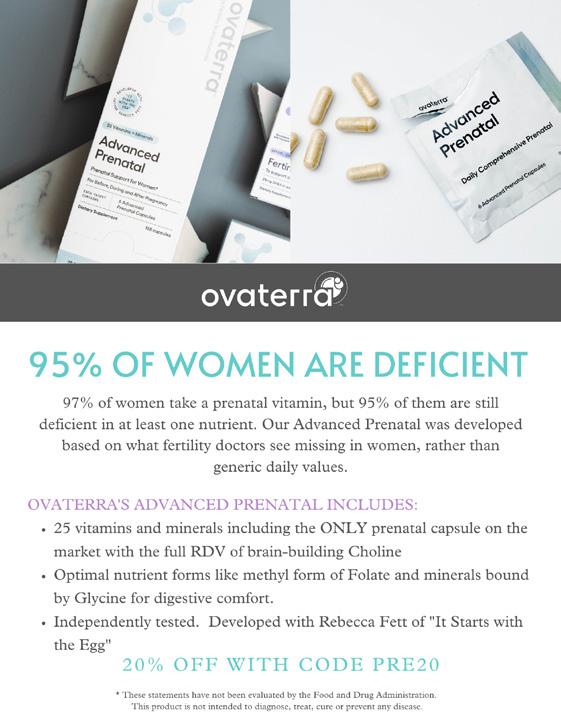
The Center for Human Reproduction Fighting for every egg and embryo Conne C t with us! www.the C hr. C om so C ial@the C hr. C om 212.994.4400 21 e 69th s t n ew York, n ew Y ork 10021 ADVERTISEMENT




























 By Norbert Gleicher, MD Founder, Medical Director and Chief Scientist
By Norbert Gleicher, MD Founder, Medical Director and Chief Scientist
























